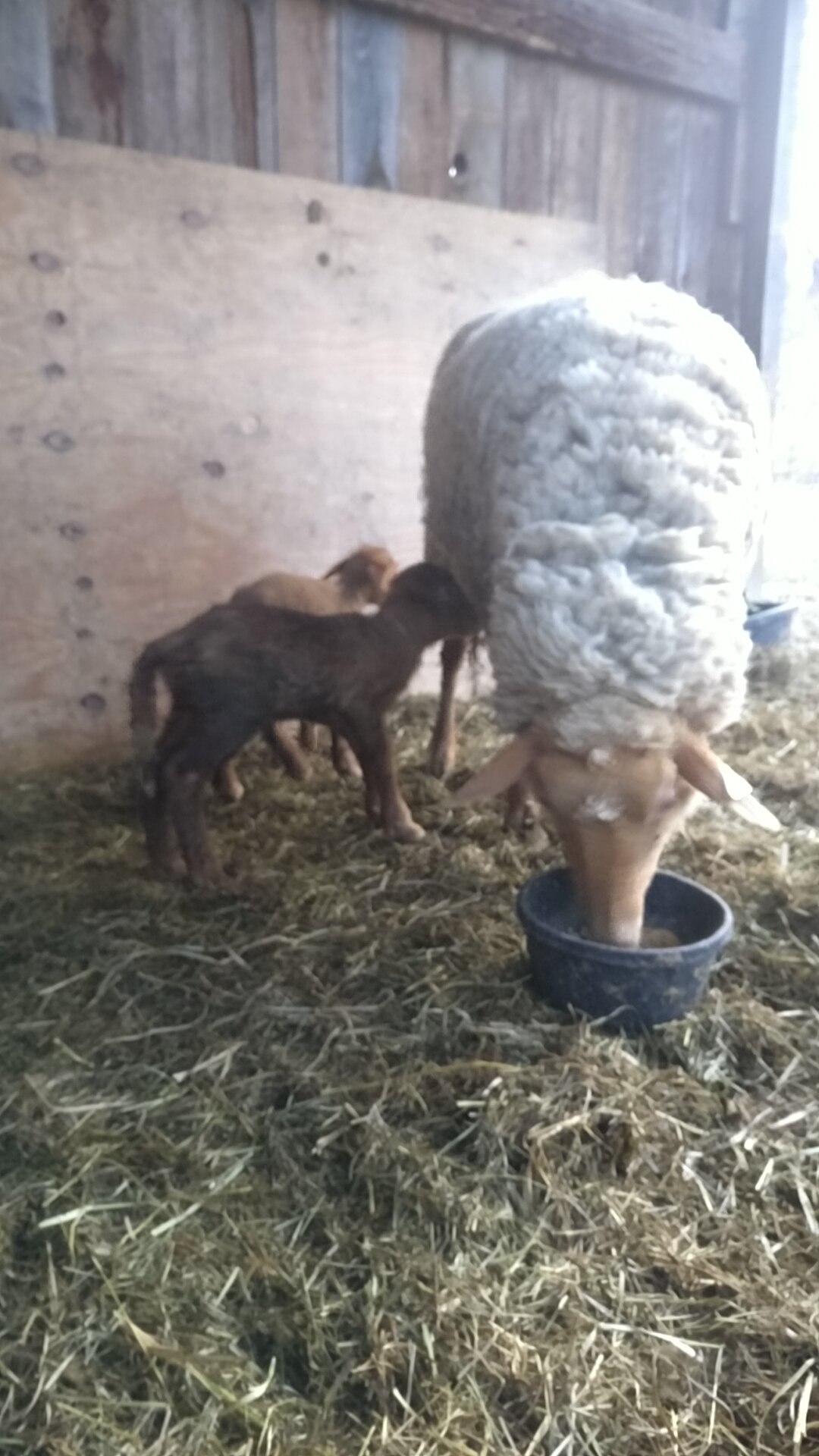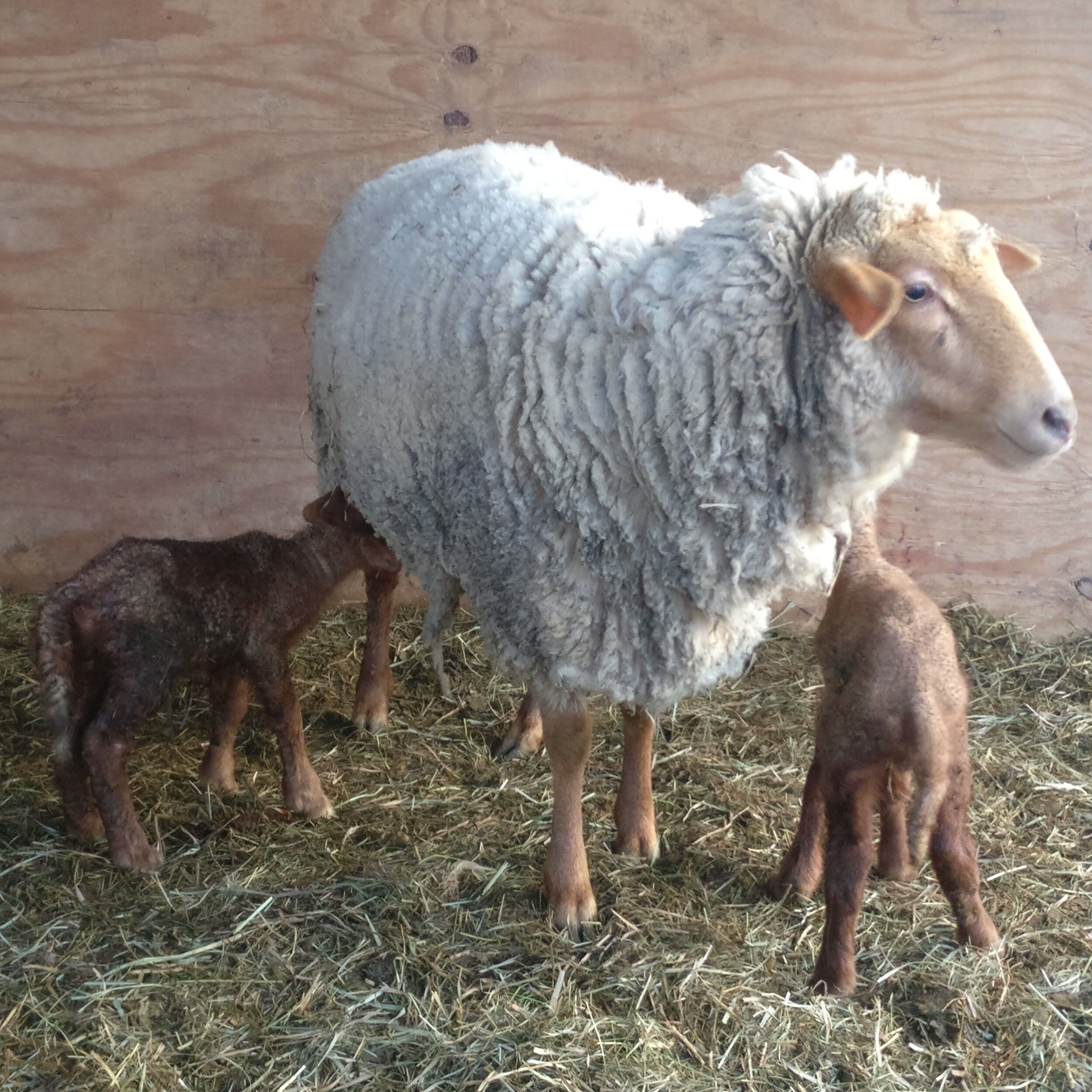We had some Tunis lams born this morning on the farm,
Excited to be selling fleeces this weekend!
We are really happy and excited to be included in the raw fleece sale for WAFA, the Wool and Fiber Arts visual sale on Facebook. My only big problem is it is only 20 degrees out today and I have like 30 fleeces left to skirt!. I got a few done yesterday, and make a decent amount of progress, but there is still a lot of work to do.
So, instead of standing outside in the cold today, I got the Etsy shop back up and running and listed a bunch of the Naturally and Acid dyed yarns listed, I made some soap for the Etsy shop as well.
It is a good thing I took this week off on vacation as I now have a lot to do!
A custom sweater
We got a very large order of yarn and roving just a few weeks ago. As soon as I had the opportunity, I dove in ans cast on an Icelandic Yoke style sweater for myself. After I lost a lot of weight a few years ago, many of my hand-knit sweaters were too big and I gave many of them away. I wanted to take the time to make one for myself to enjoy the yarn and make a sample of what could be done.
After a very slow start using a heavy fingering weight, I opted to double the yarn and things got a lot faster after that. In the end I used the Strange Brew pattern book from Tin Can Knits, and customized the yoke based on the colors we had made from the flock.
The sweater was finished yesterday and has been washed and is now blocking. During a time with a lot of turmoil, it is nice to have an accomplishment.
Felted Pumpkin Kits
Ancient Threads is happy to have felted pumpkin kits at the Adirondack Wool and Arts Festival. Directions for the kits can be downloaded here.
Coming soon….soaps and scrubs.
Coffee, brown sugar maple is my recent favorite.
Towards Our Own Cloth
I tend to see products for market along a “spectrum of saleability” with raw materials at one end and increasingly refined products at the other. Raw materials generally have a smaller market since they require further processing to make them useful. Very refined products also have a small market because they have so much value added that they are expensive and they may also have very specific uses. To have the greatest market appeal a product should be somewhere in the middle to keep the price down while having the greatest utility to the most people.
With wool, most people want the initial work of cleaning and carding done because that really is a lot of work without the right equipment. At that point your product is going to have more interest because many spinners don’t really like spinning wool “in the grease.” However, even spinners are really working towards yarn to make whatever they ultimately want to make. Getting the wool into yarn drastically increases potential customers, but your product is now on the cusp of getting kind of expensive for anything larger than socks, hats, and other small garments. A handmade sweater is fairly expensive even without putting a price on the time to make it. So perhaps yarn is the right point to stop processing ones raw wool and to put it in front of customers.
Despite these consideration, I really want cloth made from our own flock. I am not a knitter, although Lynda is a prolific one, and knitting is simply not the right approach for many items. I can see myself as a weaver, although that is currently on the long list of skills to acquire. Luckily, my work at the Battenkill Fibers Carding and Spinning Mill has put me in touch with Lilly Marsh, a weaver in Queensbury. We got a chance to visit Lilly and her husband Mike to see her workshop and to start to get a sense of direction towards our own cloth.
First of all, there is a hell of a lot more to know about weaving than the difference between warp and weft. Which of course is obvious, but I was surprised at the amount of variables there are to consider and just how much of a mechanical machine even a simple loom is. Essentially any piece of cloth is composed of threads that criss cross each other yet the possible variations are pretty much infinite. The truth is, I came away with more questions than answers and I feel like we have only dipped a toe into this field.
One detail I’m glad to know is that the right yarn can be used to create a variety of cloths. This is possible by having one type of yarn spun, keeping a portion as single ply, and then making double and triple plies from the rest. Through different combinations of warp and weft numbers and thread types we can make soft and comfy to rugged and hard wearing. Which is great since we would like to use our cloth to make garments, blankets, and bags.
The next step is sorting our wool clip into colors and types which is probably going to have to wait until warmer weather because that is bare finger work in a large area.
These photos are from Lilly’s Facebook page . She also has an Etsy page.
Repositioning
It has been eight months since my last post and I would like to say that we have made a lot of progress developing the farm, but unfortunately that isn’t the case. Although, there have been a number of shifts important to that end. Looking back over the past year, the pattern is one of wrapping up and giving up long standing projects and work relationships that distract from long term goals.
From 2012 to 2017 our primary task was to renovate and make mortgageable our new property. What I haven’t mentioned in previous posts is that I was also enrolled in a PhD program that was put on hold at the end of that time period, as well as considerably slowed over the whole duration. A little more than half of last year was spent attempting to finish, while becoming increasingly aware that the degree no longer made sense for my direction. In the end I realized that I had to walk away. Although I still feel this was the right decision it wasn’t easy and there is still regret. At the same time, Lynda has been working on a doctorate in education, which she is wrapping up now. In our re-enactment lives, we committed ourselves to what turned out to be a considerable amount of time. Although it was well worth it, it’s good to be able to reduce our time commitments. In addition to all of this, there is regular work.
A good thing that came out of the PhD research was exploring the rural entrepreneurial literature. From that, we were inspired to hold brain storming sessions with our neighboring farm owning friends in which we laid out independent and collaborative possibilities. These occurred in the early part of the year. With the onset of Fall, I looked back at how little progress we were able to make towards those goals. This caused me to wonder, just what does it take to shift direction and create something new while we are preoccupied by the routine of daily life. Which it turns out, is pretty demanding. How do we jump out of our ruts?
First of all we need to decide what our long term goals are and what we can do to promote them. To that end, I sought out employment that would support our long term goals rather than distract from them. I found it at our local fiber mill, Battenkill Fibers Carding and Spinning Mill. At first I was very part time, at only two days a week. However, the effects of the government shut down provided an opportunity to consider moving away from my former employment all together and I am now working there nearly full time. What I hope to achieve beyond a pay check is support for our farm through connections with people, access to information, development of skills, and an immersion in the world that is my occupation. The point of this is not to write a personal “tell all,” but an effort to describe what we are finding it takes to reposition ourselves to make a serious effort to farm. Obviously this process isn’t limited to farming, but is common to any attempt to follow ones passion.
My first job at the fiber mill has been the assembly of a spinning frame that was bought from a mill in Portugal and sent here by ship. It came without instructions of any kind and it has been quite the learning experience. The lead on this project is a retired engineer and degree holding physicist whose wife is a professional weaver. In my next post I’ll talk about our visit to her weaving studio through which we hope to eventually make cloth from our own wool!
Fundamental Needs?
As a fiber farmer and former fiber processor I have often contemplated what I call entrepreneurial fiber farming and the fiber arts community. I differentiate this type of farming from more traditional sheep farming, which I refer to as commodity fiber farming. Commodity fiber farming supplies wool in bulk through collection points such as wool pools, selecting for uniform characteristics that lend themselves to a consistent product. Entrepreneurial fiber farmers supply small quantities of many different types of fiber directly to fiber artists through direct sales on the farm, at fiber shows, farmers markets, and on line.
The primary question I ask, is how can this become an industry that contributes to the fundamental need of putting clothes on peoples backs from local farms? Currently the fiber arts community consists of farmers, processors, show organizers, media, celebrities, and consumers who are all part of a niche market directed at creating one of a kind art pieces and hand crafted articles of clothing. Essentially we are producing luxury goods in that they are not a part of peoples base line, everyday wardrobe. For that we get our mass produced clothes through the same outlets as everyone else. The reality is that we don’t actually have to shop anywhere else to cloth ourselves.
Personally, I would prefer to be involved in work that is meaningful in a fundamental way by contributing to real needs. Of course art, nice things, and experiences have aesthetic values that fulfill a genuine need that contributes to happiness and health. I have worked very hard to live in a place of great natural beauty because art, nice things, and experiences mean a lot to me. However, I want to know that my work also contributes in a fundamental way.
I’ve come to the conclusion that the fiber arts community does contribute in fundamental ways through the preservation and development of fiber and textile skills and knowledge, and the preservation of fiber animal breed diversity. Although none of us fundamentally need nalbound naturally dyed socks made from an icelandic/alpaca wool blend that was hand spun and made on bone needles, the people that did all that are preserving a host of things that the world would be poorer without. In addition, although I don’t want to sound like a preper for the apocalypse, someday all of this might come in really handy should the availability of mass produced clothing come to an end.








